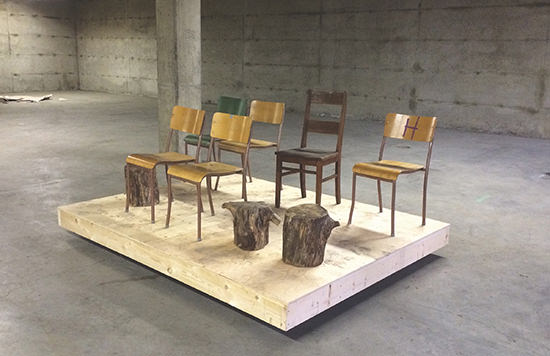Radically adrift in an expanding cosmos
Mikis Vrettakos: Fight With a Stick, Revolutions

Revolutions, Fight with a Stick
I’m sitting with 20 spectators on a small wooden platform. We’re very close to performer Sean Marshall Jr who is at a table with a small stack of books. Next to him is an ancient brass bed covered in a mountain of white sheets. Hidden under the linen, someone (Delia Brett) has been rolling back and forth in an almost imperceptible wave-like motion. The wrinkles in the sheets are what hold my attention—it’s more about the fabric than the figure beneath.
We’ve been confined to a very small room. Clues to a greater expanse are evident in Nancy Tam’s sound design—small creaks and a clarinet-like drone issuing from beyond the room suggest distance. The man begins to read from one of the books: “The reward of patience is patience. The cure for boredom is curiosity.” Aphorisms. The more I hear, the funnier and more meaningless they become. And the queasier I get. For some time I’ve been feeling mildly disoriented. I notice the bed has moved away from me. When did this happen? I realise with astonishment that it’s actually the audience platform that’s been moving—backward, inch by inch. The man has been following with us while the bed and back wall have receded. The plywood walls have stretched: the room is becoming a tunnel, longer by the minute. The bed is now way back there, and even the aphorism-speaker is getting smaller.
His search for some kind of truth in the book has felt sincere, as if finding the right tired cliché will give him the key to something. As the interior setting becomes somewhat miniaturised through distance, the whole scenography becomes less about the man’s search and more about relationships between things, audience included. I’ve read that the making of Revolutions was influenced by philosopher Jane Bennett’s theory of “vibrant matter” with its agency of things, human and non-human, and how “assemblages” of matter (a term from Deleuze) work in confederation to produce situations of shorter or longer duration. Fight With a Stick claims to have rehearsed “in confederation” with found and constructed materials to create Revolutions.
This becomes most evident when cracks appear in the walls and new objects begin to slide into the long tunnel. They’re rough, discarded objects: beach-worn planks or small timbers with large rusted hinges. As the man fades, the objects take over. They become aggressive. A huge stone-like block pushes in and out on the right. Then the back wall presses forward, sweeping the bed, table and other objects along, compressing the space (the man has disappeared unnoticed). Just before crashing into us, the carnage screeches to a halt.
.jpg)
Revolutions, Fight with a Stick
With an earth-shaking rumble the whole scene now explodes in slow motion. The wall on the right breaks apart in many sections. Each section floats away into the now visible warehouse. A far-away wall of concrete is revealed. It seems to have broken into geometrical sections that slide in and out of each other like puzzle pieces. This is a video projection of the wall onto itself. Closer, on my right, the moving pieces of wall pick up another projection—the grain of the plywood surfaces projected onto themselves. Video artist Josh Hite employed this technique—taking content from the actual space and disorienting the viewer by projecting it back onto itself as a moving image—in Steppenwolf, the company’s previous show.
When one of the walls suddenly rockets across the warehouse, followed by a second, a third and then several more, the effect is both terrifying and exhilarating. Tam’s sound installation thunders in sympathy. She’s mixed outside traffic, including rumbling transit trains, with the natural reverberating chamber of the venue. The walls, debris and rolling audience platform (all designed by performance artist Jay White) have been freed from the earlier human-scale domestic setting. We’ve been set adrift in an expanding cosmos. Revolutions seems to be about this relationship between our little domestic worlds and a nonhuman immensity of which we are only a part. The title suggests the traditional impulse to change society, but through a spatial exercise of portraying entropy we come to see our efforts in a much broader context.
Fight With a Stick, in only its second production, has put down a marker. The company’s collaborative approach is truly interdisciplinary and its spatial performance design is unique, both in concept and visceral affect. I find it particularly exciting that the work appeals to theatre and visual arts audiences alike. Historically, this relationship has been fruitful but uneasy. In Revolutions the opposing time-scales of gallery art and theatrical performance find revelatory convergence.
.jpg)
Sean Marshall Jnr, Revolutions, Fight with a Stick
Fight With a Stick, Revolutions, co-directors Alex Lazaridis Ferguson, Steven Hill, set design Jay White, sound design Nancy Tam, video design Josh Hite, collaborators Delia Brett, Beckett Ferguson, Sean Marshall Jr, Carmine Santavenere, Paula Viitanen; The Warehouse, Vancouver, Canada, 19-29 May
RealTime issue #133 June-July 2016






